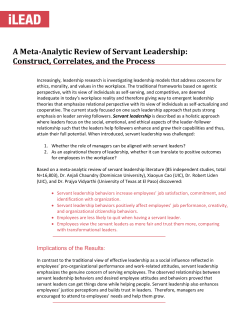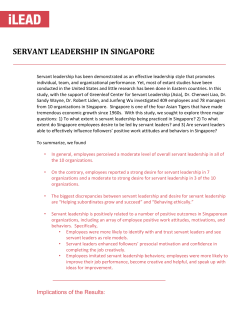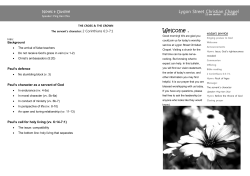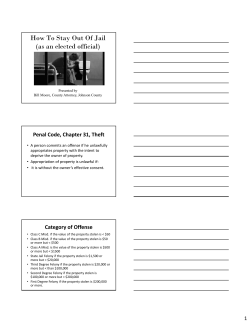
Servant Leadership: Growing into the Future h Dr. Kent M. Keit
The Greenleaf Seminar Servant Leadership: Growing into the Future Presented by Dr. Kent M. Keith CEO, Greenleaf Center for Servant Leadership Marylhurst University – March 22, 2012 © Copyright Greenleaf Center for Servant Leadership 2012 1 Questions… What was the “management theory” context in which Greenleaf first articulated his ideas about servant leadership? How do we define servant leadership? What makes servant leadership effective? What are the prospects for the growth of servant leadership in the future? 2 The Modern Context 3 Robert K. Greenleaf (1904-1990) Worked for AT& T for 38 years; eventually became Director of Management Research Launched the modern servant leadership movement with his essay, The Servant as Leader, published in 1970 after he retired Friend of Peter Drucker and acquaintance of Douglas McGregor 4 Douglas McGregor (1906-1964) Professor of Management at Sloan School of Management, MIT President of Antioch College, 1948-54 Coined “Theory X” and “Theory Y” regarding assumptions about people in the workplace “Theory Y” was based on Abraham Maslow’s “Humanistic School of Psychology” 5 The Human Side of Enterprise (1960): Theory X Most people dislike work and will avoid it if they can. Because they don’t like work, most people must be coerced, controlled, or threatened with punishment to get them to work toward the achievement of organizational objectives. Most people want to be directed, and want to avoid responsibility. They have little ambition. They just want to be secure. 6 Douglas McGregor: Theory Y Work is as natural as play or rest. The threat of punishment is not the only way to get people to work. People will exercise self-direction and selfcontrol in working toward organizational objectives when they are committed to them. 7 Douglas McGregor: Theory Y Commitment to objectives is a function of the rewards associated with their achievement. Most people learn not only to accept but to seek responsibility. 8 Theory Y A lot of people have the capacity to exercise a relatively high degree of imagination, ingenuity, and creativity in solving organizational problems. Under the conditions of modern industrial life, the intellectual potential of most people is only partially utilized. 9 Robert Greenleaf went further than Theory Y Greenleaf was invited by McGregor to teach at MIT Greenleaf went further than Theory Y, urging a pro-active focus on the growth of the people within the organization. Greenleaf: A leader who accepts this would say: “I am in the business of growing people.” 10 Defining the Servant-Leader 11 The Servant as Leader Greenleaf’s classic essay, The Servant as Leader, was published in 1970, ten years after McGregor’s The Human Side of Enterprise Known as “the orange book,” it has been read by hundreds of thousands of people since 1970 Greenleaf’s 1977 collection of essays ranks high even today on the Amazon.com list of mostread books on leadership (#15,000 all books) 12 Greenleaf’s definition of the servant-leader (p.9) The servant-leader is servant first… It begins with the natural feeling that one wants to serve, to serve first. Then conscious choice brings one to aspire to lead. That person is sharply different from one who is leader first, perhaps because of the need to assuage an unusual power drive or to acquire material possessions… 13 Servant-first and other people’s priorities The difference manifests itself in the care taken by the servant-first to make sure that other people’s highest priority needs are being served. 14 The best test of a servant-leader Do those served grow as persons? Do they, while being served, become healthier, wiser, freer, more autonomous, more likely themselves to become servants? 15 Caring for the least privileged And, what is the effect on the least privileged in society? Will they benefit or at least not be further deprived? 16 Greenleaf: Characteristics of servant-leaders Most important characteristic: the desire to serve Listening and understanding; acceptance and empathy; foresight; awareness; persuasion; conceptualization; selfhealing; and rebuilding community. 17 Greenleaf: Characteristics of servant-leaders Servant-leaders initiate action, are goaloriented, are dreamers of great dreams, are good communicators, are able to withdraw and re-orient themselves, and are dependable, trusted, creative, intuitive, and situational. 18 Greenleaf on the ultimate goal of servant leadership Leaders become servant-leaders and help their organizations to become servantinstitutions Servant-institutions focus on serving their employees, customers, and communities The quality of our lives improves, and we live in a more just and caring society 19 Larry Spears: Ten characteristics Larry Spears, the CEO of the Greenleaf Center for 16 years, selected ten characteristics of servant leadership: Listening, empathy, healing, awareness, persuasion, conceptualization, foresight, stewardship, commitment to the growth of people, and building community 20 Bob Liden: Servant leadership dimensions Liden et al., article in The Leadership Quarterly in 2008, identified nine servant leadership dimensions: emotional healing, creating value for the community, conceptual skills, empowering, helping subordinates grow and succeed, putting subordinates first, behaving ethically, relationships, and servanthood. 21 Dirk van Dierendonck: Six key characteristics Professor, Erasmus University, Holland; article in Journal of Management in 2010: Servant-leaders empower and develop people; they show humility; are authentic; accept people for who they are; provide direction; and are stewards who work for the good of the whole. 22 Laub: Organizational Leadership Assessment Dr. Jim Laub developed the Organizational Leadership Assessment (OLA) to assess organizational health based on six key areas of effective organizational leadership: Display authenticity, value people, develop people, build community, provide leadership, share leadership 23 Servant Leadership Compared with Other Ideas 24 Theories proposed since Greenleaf (1970) Transforming/Transformational Leadership… Theory Z… Leader-Member Exchange (LMX)… Ethical Leadership…Level 5 Leadership…Authentic Leadership… Adaptive Leadership…Spiritual Leadership…Empowering Leadership… Self-Sacrificing Leadership… 25 What is unique to servant leadership Based on the views of scholars, the elements that are most unique to servant leadership compared with other theories are the moral component the focus on serving followers for their own good, not just the good of the organization, and forming long-term relationships with followers, encouraging their growth and development so that over time they may reach their fullest potential 26 What is unique to servant leadership concern with the success of all stakeholders, broadly defined—employees, customers, business partners, communities, and society as a whole—including those who are the least privileged; and self-reflection, as a counter to the leader’s hubris. 27 Dirk van Dierendonck: Comparing theories Van Dierendonck studied seven leadership theories that revealed the most overlap with servant leadership: transformational leadership, authentic leadership, ethical leadership, Level 5 leadership, empowering leadership, spiritual leadership, and self-sacrificing leadership. 28 Dirk van Dierendonck: Comparing theories Van Dierendonck concluded that none of the seven theories incorporates all six characteristics of servant leadership, which puts servant leadership in a unique position. Additionally, servant leadership theory distinctly specifies a combined motivation to become a leader with a need to serve that is at the foundation of these behaviors. 29 Greenleaf vs. Scholars Greenleaf proposed a philosophy, characteristics, and practices—not a theory Scholars study leaders and followers Greenleaf’s writings are about leaders who work closely with their colleagues, deliver services to their customers, and benefit society at large LeadersColleaguesCustomersSociety 30 Servant Leadership Is Effective 31 What servant leadership is not It is not soft—the servant-leader can make hard decisions (but the decisions are made to serve others, not to gain personal power) It is not about a single style of leading– the servant-leader uses whatever style is needed to effectively address each person or situation 32 Servant-leaders get two kinds of results They obtain the resources to continue and if possible expand the work of the organization (e.g., a profit or surplus) This is an organizational need They serve their colleagues and customers, and make the world a better place This is the organization’s purpose 33 “High-commitment high-performance CEOs understand that being part of an enterprise that is helping to create a better world unleashes the commitment and energy of their people.” “The Uncompromising Leader,” July-August 2008, by Eisenstat, Beer, Foote, Fredberg, Norrgren 34 Key Practices of Servant-Leaders Self-Awareness Listening Changing the pyramid Developing your colleagues Coaching, not controlling Unleashing the energy and intelligence of others Foresight 35 Research on the Impacts of Servant Leadership in the Workplace 36 Building strong teams Servant-leaders gain team member trust and build long-term relationships Servant-leaders promote open and problemdriven communication within the team Servant-leaders cultivate personal integrity, and help team members to cooperate with and care about each other Dr. Robert Liden, University of Illinois at Chicago 37 Facilitating effective teamwork Servant-leaders facilitate team confidence, affirming the strengths and potential of the team and providing development support Servant-leaders facilitate effective team behaviors Hu & Liden, Journal of Applied Psychology, 2011 38 Enhancing performance and commitment Servant leadership may enhance both job performance and commitment to the organization Servant-leaders may inspire followers to take an active role in serving the community in which the organization is embedded Liden , Wayne, Zhao & Henderson, Leadership Quarterly, 2008 39 More helping and creative employees Empirical research has revealed that employees of servant-leaders are more helping and creative than those working with leaders who scored lower on servant leadership. Neubert, Kacmar, Carlson, Chonko, & Roberts, Journal of Applied Psychology, 2008 40 More organizational citizenship behaviors Servant-leader behaviors are related to organizational justice (fairness in decisions made regarding employees), which in turn leads employees to reciprocate by engaging in organizational citizenship behaviors (OCBs). Ehrhart, Personnel Psychology, 2004 41 Enhanced self-efficacy Servant leadership encourages OCBs by enhancing self-efficacy (people’s self confidence in their ability to perform specific tasks well), creating a service climate at work, and establishing a fair workplace. Walumbwa, Hartnell & Oke, Journal of Applied Psychology, 2010 42 Greater job satisfaction Servant leadership has been shown to be positively related to employee job satisfaction Mayer, Bardes & Piccolo, European Journal of Work and Organizational Psychology, 2008. 43 Case study: Nurse managers In a study at a hospital, nurses who perceived that their nurse managers had a higher servant leadership orientation demonstrated greater job satisfaction Jenkins & Stewart, “The importance of a servant leader orientation,” Health Care Management Review, 2010 44 Back-of-the-Envelope Research 45 Better than Great Comparison of “Good to Great” companies with servant-led companies Ten year period ending in 2005 500 largest companies = 10.8% return “Good to Great” = 17.5% return Servant-led companies = 24.2% return 46 Future Prospects for Growth 47 Negative Factors Theory X and the power model of leadership are still dominant in most cultures Many people do not understand servant leadership, or will not support or reward it People in leadership positions may feel threatened by servant leadership Servant leadership is more effective in the long run but takes an up-front commitment to invest a lot of time and energy to grow people 48 Positive Factors Servant-leaders get results in ways that serve individuals, organizations, and society at large The emphasis on growing people is strategic Servant leadership may be preferred by many millennials Servant leadership can work in many cultures --it has a worldwide future 49 Creating Shared Value Article by Michael Porter and Mark Kramer in the January-February 2011 issue of HBR Companies are widely perceived to be prospering at the expense of the broader community; their legitimacy has fallen They should focus on “shared value”—creating economic value in a way that also creates value for society by addressing its needs/challenges 50 Growing people is strategic When people grow, the capacity of the organization grows. When the capacity of the organization grows, it can do things better, or do things it was never able to do before. Individuals benefit, the organization benefits, and those served benefit. 51 The Trophy Kids Grow Up by Ron Alsop 92,000,000 milennials (born 1980-2001); larger group than Gen X (62,000,000) They don’t like an authoritarian, command-andcontrol style of management; they prefer collaboration, teams Status and hierarchy don’t impress them; they want to be colleagues not subordinates Greenleaf: council of equals, inverted pyramid 52 The Trophy Kids Grow Up by Ron Alsop They want to be rewarded for performance, not wait around for seniority; they want meritocracy They will work hard if the task is engaging and promises a tangible payoff; they want meaningful work, to make a difference Greenleaf ethic: the work exists for the person as much as the person exists for the work; work should be meaningful to those doing it 53 The Trophy Kids Grow Up by Ron Alsop They will change jobs often, to keep growing They want more coaching, training, and mentoring programs Greenleaf: servant-leaders help their colleagues grow; they coach, train, and mentor them Milennials see their careers and personal lives as one—not balancing but blending them 54 U.S. ethnic minority attitudes toward leadership In Salsa, Soul, and Spirit, Juana Bordas noted that for many Hispanic Americans, AfricanAmericans, and Native Americans: Leadership positions belong to the community, not the individual leader Leadership positions are not for personal gain but for service to the larger community Leadership positions are rotated 55 Studies regarding Servant Leadership in Other Countries 56 Public Sector Leaders in China Article by Han, Kakabadse & Kakabadse in Journal of Management Development (2010) Servant leadership seen as a way to help restore employee’s trust, commitment and confidence in management, as well as a way to attract and retain high performance employees Three sources for Chinese servant leadership: Confucianism, Daoism, and communist ideology 57 Public Sector Leaders in China Confucian characteristics: courtesy, obedience, respect to seniors, loyalty, moderation, forgiveness, wisdom, benevolence Daoist characteristics: vision, insight, wisdom, serving the community, humility, leading by example, empowering others Communist ideology: willingness to serve the people whole-heartedly; placement of collective interests above self-interest 58 Public Sector Leaders in China Servant leadership behaviors reported: Putting people first; assisting subordinates Ethical behavior Moral (agapao) love, caring for others Conceptual skills, organizational knowledge Humility, not seeking public attention Building long-term relationships, knowing and supporting others 59 Public Sector Leaders in China Three types specific to Chinese context: Being dutiful Devotion to Party policies and state laws Listening Western perceptions not found: Creating value for the community Empowering, persuasive mapping Transcendent spirituality 60 Republic of Ghana Article by Hale and Fields, published in Leadership (2007) comparing seminary students in Ghana and the United States In earlier periods of Ghana’s history, kings were expected to be servants to the clan or tribe Contemporary Sub-Saharan Africans want leaders who are strategy and goal-directed, demonstrating good character, competency, compassion, justice and wholeness 61 Republic of Ghana Respondents from Ghana reported servant leadership behaviors less frequently There is a high power difference; people in power are viewed as being different than others (visionaries, not “first among equals”) In-group members expect preferential treatment (not concerned with building a larger community with out-group members) 62 Republic of Ghana Development of followers was not consistent with leadership behavior norms in Ghana Building relationships among co-workers was not consistent with in-group behavior in Ghana There were no significant differences in the effects of service and humility between Ghanaian and American sub-samples 63 Bedouin-Arab Culture Article by Yasin Khalaf Sarayrah, “Servant Leadership in the Bedouin-Arab Culture,” Global Virtue Ethics Review (2004) Main elements of servant leadership were present in early Arab culture In traditional Bedouin desert society, the chief was seen as an equal and not a boss 67 Bedouin-Arab Culture Even Prophet Mohammed consulted with his followers when there was no revelation In the following hadith, Prophet Mohammed urged Muslim leaders to be servant-leaders: “Verily, each of you is a shepherd, and each of you is responsible for the well being of the flock.” 67 Bedouin-Arab Culture The second Caliph, Omar Bin al-Khattab (7th century) was a servant leader Was able to listen and accept criticism Planned and organized new Islamic state Promoted the participation of others in decision making Empathized with others; supported the poor; provided pensions for soldiers 66 Bedouin-Arab Culture Over the centuries, the original simple desert Arab/Islamic norms and values were abandoned or given new meaning However, in the 20th century, areas of South and East Jordan retained the traditions Tribal proverb regarding hospitality: “The youngest is the servant and the one who rules is likewise the servant.” 67 Studies of Leadership in Various Cultures 68 Servant Leadership Across Cultures Fons Trompenaars and Ed Voerman, 2009 Dilemmas for leaders: Leading vs. serving, rules vs. exceptions, parts vs. the whole, control vs. passion, specific vs. diffuse, shortterm vs. long-term, and push vs. pull THT: Cultural values of 90,000 people, with 8,000 dilemmas validated by 1,500 interviews 69 Servant Leadership Across Cultures Different countries and cultures lean in different directions regarding the dilemmas Organizational structure: (A) so everyone knows who is in charge or (B) so everyone knows how tasks are divided and coordinated B = 44% in Venezuela, 66% in Romania, 80% in Russia, 92% in USA, 100% in Malaysia, South Africa, and Denmark 70 Servant Leadership Across Cultures The authors argue that servant leadership deals with the leadership dilemmas by paradoxically combining the elements That is why servant leadership can be successfully implemented all over the world Problems with this study: dilemmas are not paradoxes; choices not combinations 71 GLOBE Study “Global Leadership and Organizational Behavior Effectiveness” was a 62-nation, 11year study involving 170 researchers worldwide. Data were collected from 17,300 middle managers from 951 organizations The first report was more than 800 pages 72 GLOBE Study One of the most important questions addressed by the GLOBE research team concerned the extent to which the practices and values associated with leadership are universal (i.e., are similar worldwide), and the extent to which they are specific to just a few societies 73 GLOBE Study Findings The study found a set of “culturally endorsed leadership theory dimensions” Those six CLT’s were: Charismatic/value-based, team oriented, participative, humane oriented, selfprotective, and autonomous 74 GLOBE Study Findings All cultures saw the charismatic/value-based dimension as contributing to outstanding leadership. This included the leader’s ability to inspire, motivate, and expect high performance outcomes on the basis of his or her firmly held core values. This included self-sacrifice, integrity, decisive, and performance oriented. 75 GLOBE Study Findings All cultures saw team orientation as contributing substantially to outstanding leadership. This emphasized effective team-building and implementation of a common purpose or goal among team members. 76 GLOBE Study Findings Germanic Europe most positively associated participative with outstanding leadership. Humane oriented (supportive and considerate leadership, including compassion) was viewed as only moderately contributing to outstanding leadership. 77 GLOBE Study Findings Self-protective (self-centered, status conscious, face-saver, conflict-inducer, procedural) was viewed as not contributing to outstanding leadership Autonomous (independent and individualistic) was viewed as not contributing to outstanding leadership. 78 GLOBE Study and Servant Leadership Charistmatic/value based and team oriented are seen by all cultures as contributing substantially to outstanding leadership These characteristics are consistent with servant leadership, so these aspects of servant leadership may work worldwide 79 GLOBE Study and Servant Leadership Participative and humane oriented are consistent with servant leadership but are viewed by only some cultures as contributing to outstanding leadership Self-protective and autonomous are contrary to servant leadership and are viewed as not contributing to outstanding leadership 80 GLOBE Study and Servant Leadership The GLOBE study was not a study of servant leadership, but servant leadership is consistent with the views of all cultures regarding what does and what does not contribute to outstanding leadership The “middle ground” reveals variations by culture 81 Future potential Servant-leadership will be the accepted standard for all leaders because it is the most ethical, practical, meaningful way to lead Servant-leadership will be accepted as the best way to get results because the results are achieved by serving individuals, organizations, and society at large (creating shared value) 82 Future potential Growing people will be understood to be a highly strategic core responsibility of leaders Servant leadership will be demanded by many milennials, who will change the workplace Servant leadership principles will help change the world by its adoption in many countries Some challenges that go beyond national boundaries will be successfully addressed 83 Questions… Comments… 84 Thank you! 85
© Copyright 2025













